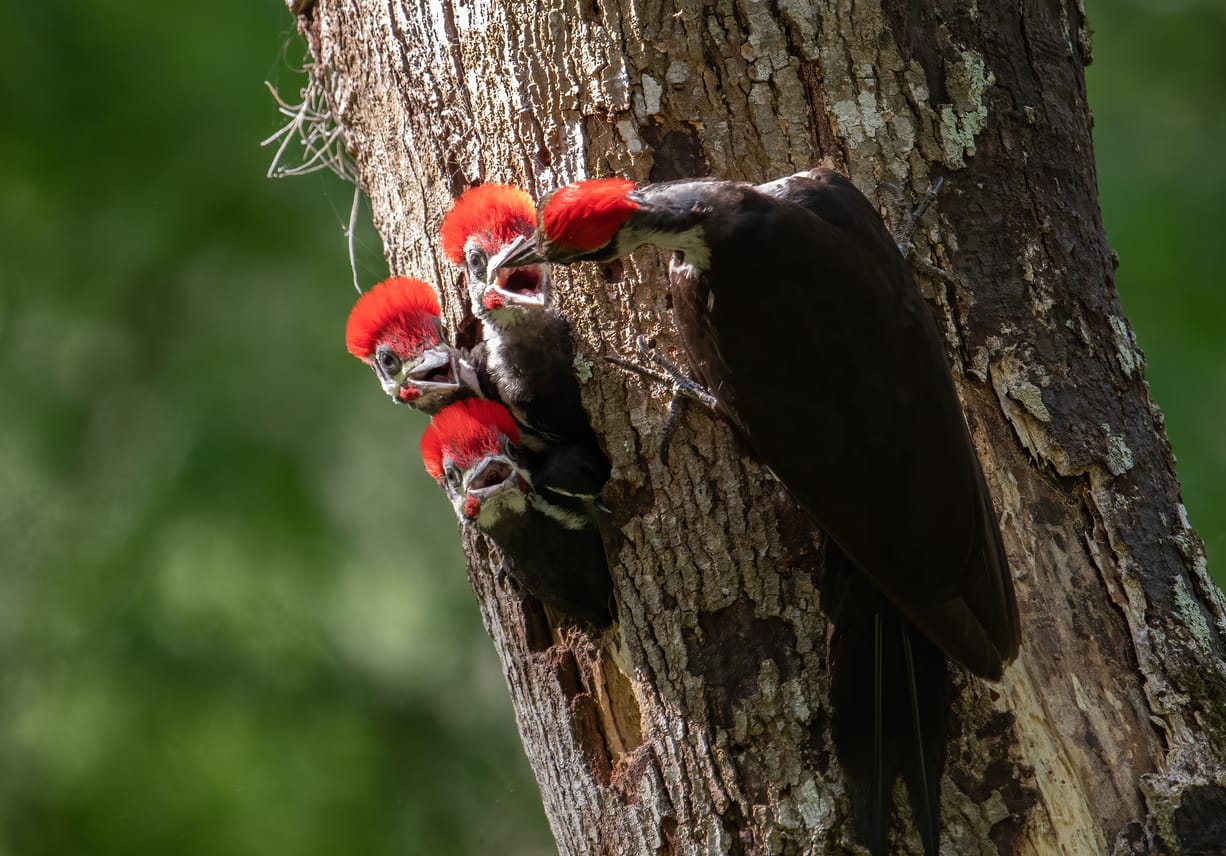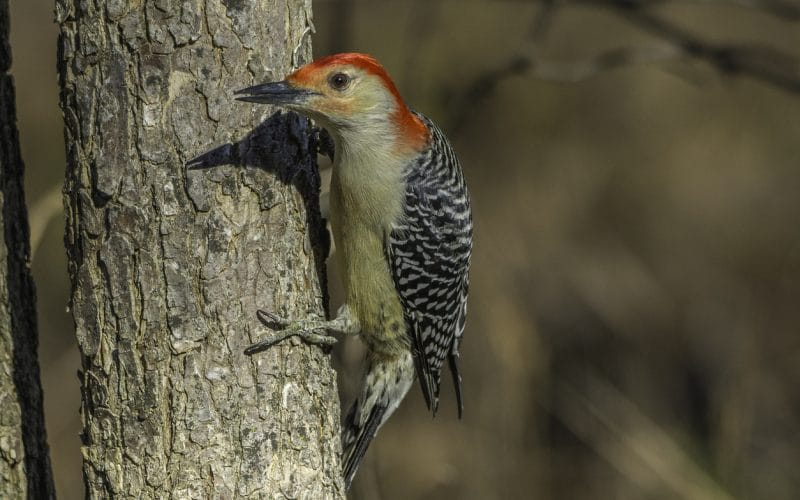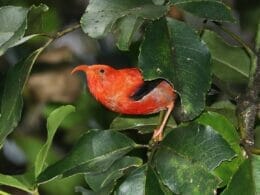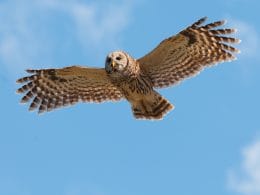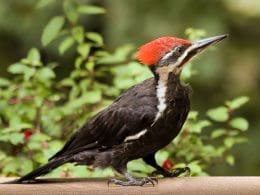The Sunshine State is notorious for its rich wildlife, and it definitely stands up to that reputation when it comes to birdwatching.
Obviously, no birdwatcher’s list is complete without some drumming woodpeckers!
All in all, there are a few woodpeckers in Florida that you can spot. Some of them are more common than others, but they’re all fabulous looking.
Spotting Woodpeckers in Florida
Let’s get this show on the road with ten of the prettiest woodpecker species you can spot in Florida:
1. Red-Bellied Woodpecker
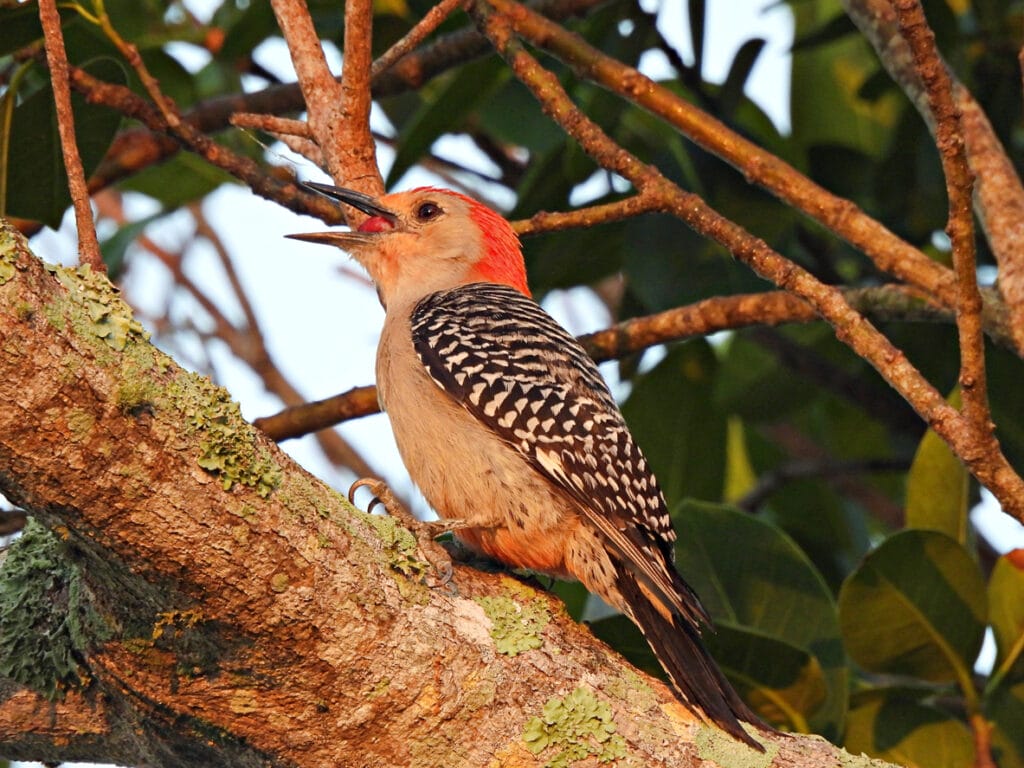
- Scientific name: Melanerpes carolinus
- Length: 9.4 in
- Wingspan: 2-3.2 oz
- Weight: 13-16.5 in
The species is one of the common residents all over the eastern parts of the United States.
Besides being relatively abundant in Florida, the Red-Bellied Woodpecker is strikingly easy to identify. Thanks to its striped back and orange-red cap, its appearance is unmistakable.
Don’t let the name fool you, though. Its belly is actually creamy white, not red in the slightest.
To find your way to one of those red-caped bad boys, head to a forested area and listen for a sharp rolling call.
They might even show up in populated cities during the winter. So, don’t shy away from hanging suet feeders during the cold days, especially if you have dense trees in your backyard. Just keep an eye out for your wintering berries. They might gulp them right up.
If you get a chance to watch the Red-Bellied Woodpecker feed, you’ll see their extremely long tongue with almost two inches past their beaks!
Author Note: While the tongue itself isn’t sticky, the saliva is. As gross as it sounds, this helps the birds snatch prey from the smallest nooks and crannies in tree trunks.
But perhaps the most beautiful thing to spot with the Melanerpes carolinus is their flight playtime. Yes, these birds fly aimlessly, repeating their calls just for fun!
2. Gold-Fronted Woodpecker
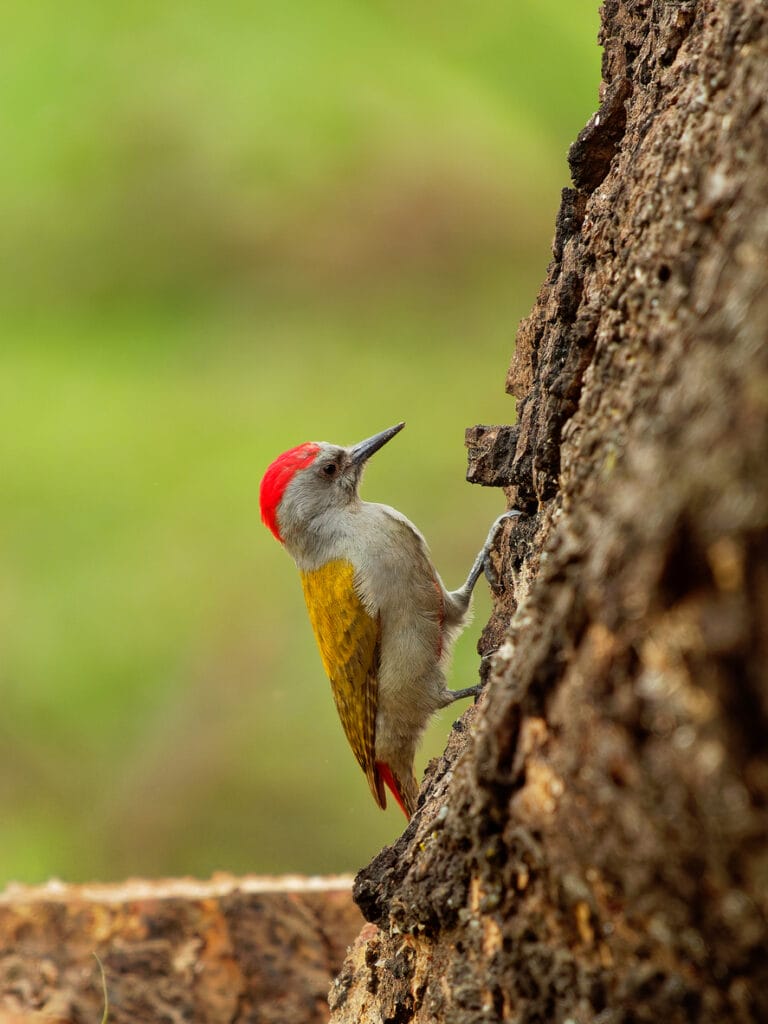
- Scientific name: Melanerpes aurifrons
- Length: 8.7-10.2 in
- Wingspan: 16.5-17.3 in
- Weight: 3.6-3.5 oz
The Gold-Fronted Woodpecker is a close relative of the Red-Bellied Melanerpes, and it shows.
They’re almost identical in every aspect, except that their cap-like coloration is a bold shade of golden-yellow instead of red.
It’s not as much of a common Florida species as the Red-Bellied variety, but you still have decent odds of spotting this golden bird around Pensacola.
However, the majority tend to prefer living down south in Texas, eastern Mexico, and the northern parts of Central America.
While the population of the Gold-Fronted and Red-Bellied Melanerpes don’t usually overlap, there’s evidence that they crossbreed.
A little fun fact about the Gold-Fronted Woodpecker is that they’re mostly monogamous. Once they pick their partners in early spring, they’re set for the full year.
As a pair, the birds perform ritualized flight dances and tapping calls. They can also be very territorial when it comes to protecting their nest, even against their own species.
3. Downy Woodpecker

- Scientific name: Dryobates pubescens
- Length: 5.5-6.7 in
- Wingspan: 9.8-11.8 in
- Weight: 0.7-1 oz
The Dryobates pubescens is one of the smallest woodpeckers in North America, but it’s widespread from coast to coast.
It can adapt and live in various environments, from river groves to mountain ranges. It’s not even that shy of a bird, and it often pops up in backyards to forage on small branches.
Yet, the bird usually prefers living in riparian areas and deciduous trees where they nest in dead trees, of all options!
Appearance-wise, it might remind you of a penguin. It’s white and black all over with a dark eyeshade, a small red spotting on its head, and a small triangular peak.
However, the Pacific population stands out with small spots on the wing and a slightly faded black plumage. This is mostly the variety that you’ll get to see in Florida.
To match its tiny body, the Downy Woodpecker has a soft tweak for a call. It often sounds weak and whiny.
Much like other birds, their calls become more persistent during the breeding season around late winter.
Just keep in mind that its petite figure helps it hide well from sight. So, you might need to look twice before spotting the Downy Woodpecker from a distance.
4. Hairy Woodpecker

- Scientific name: Dryobates villosus
- Length: 7.1-10.2 in
- Wingspan: 13.0-16.1 in
- Weight: 1.5-3.5 oz
The Hairy Woodpecker can almost pass as a larger duplicate of the Downy Woodpecker.
If you’re looking to tell them apart, the most obvious difference is in their bills. The Hairy Woodpecker’s peak is much longer and sharper.
This creates a clear distinction in their profiles. So, it might be easier to identify the bird if you see it from the side view.
Plus, the Downy Woodpecker’s proportions make it seem like a chubbier version when compared to the tall and slim Hairy Woodpecker.
Top Tip: You can also confirm your identification when you hear the sharp and loud call versus the soft tweaks.
They even show similar behaviors in nesting in dead limbs. Of course, the nest height is different, depending on the bird’s size.
While it’s normal to see both species’ populations overlap, the Dryobates villosus is a little less common in Florida. It’s also relatively rare in southern States like Texas.
5. Yellow-bellied Sapsucker
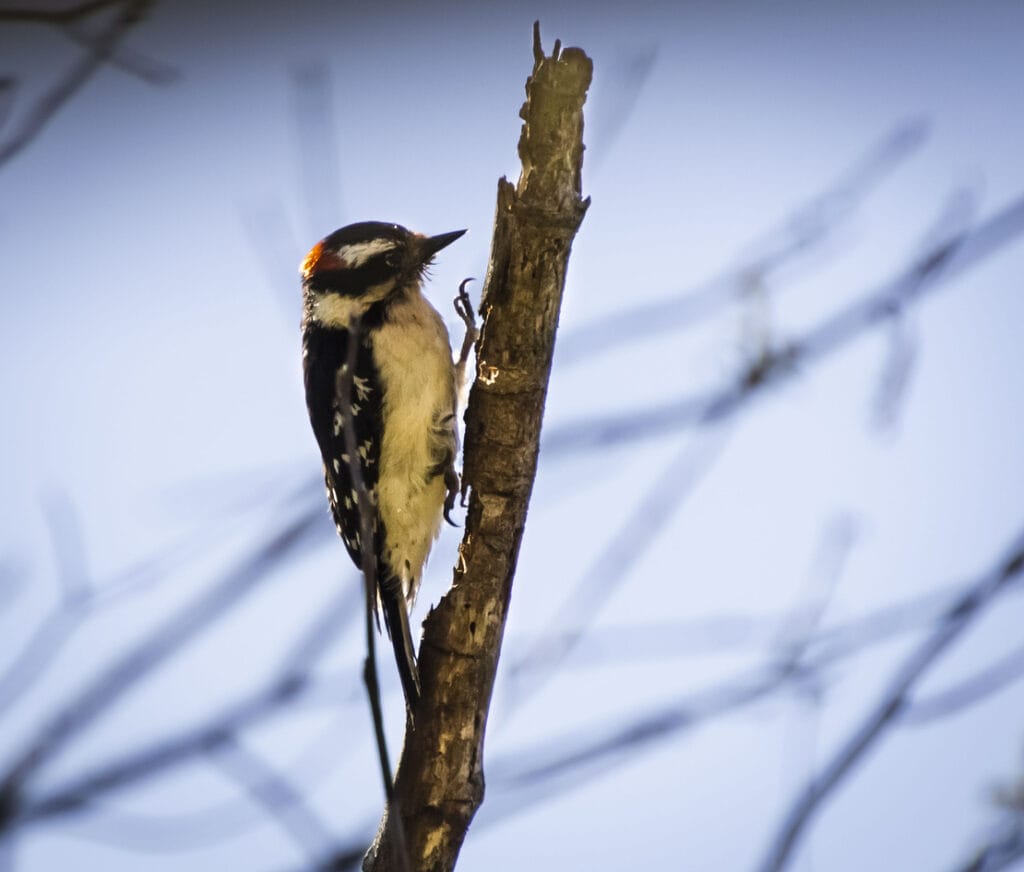
- Scientific name: Sphyrapicus varius
- Length: 7.1-8.7 in
- Wingspan: 13.4-15.8 in
- Weight: 1.5-1.9 oz
Although it’s not a year-round resident, the Yellow-bellied Sapsucker is a common wintering bird in Florida.
While it’s not particularly heavy, its weight distribution makes it look stout and comical. It even has the colors to go with the figure, from a bold red nape to the yellow-spotted underparts.
The sharp transition from black, white, and red on the bird’s head are very distinctive, too!
To add to its comical features, the bird’s call sounds a lot like a baby cat, ranging between churrs and nasal squeals. It quiets a bit during the winter but gets back to its cheery mood in the spring.
The plump bird is more than just a cheery little fellow, though. It has an important job to tend to. After all, it plays an important role in maintaining the ecosystem at all the stops along its migration route.
Keep in mind that it covers a large distance traveling each year. In fact, there’s no overlap between its summer and winter homes.
6. Red-Cockaded Woodpecker
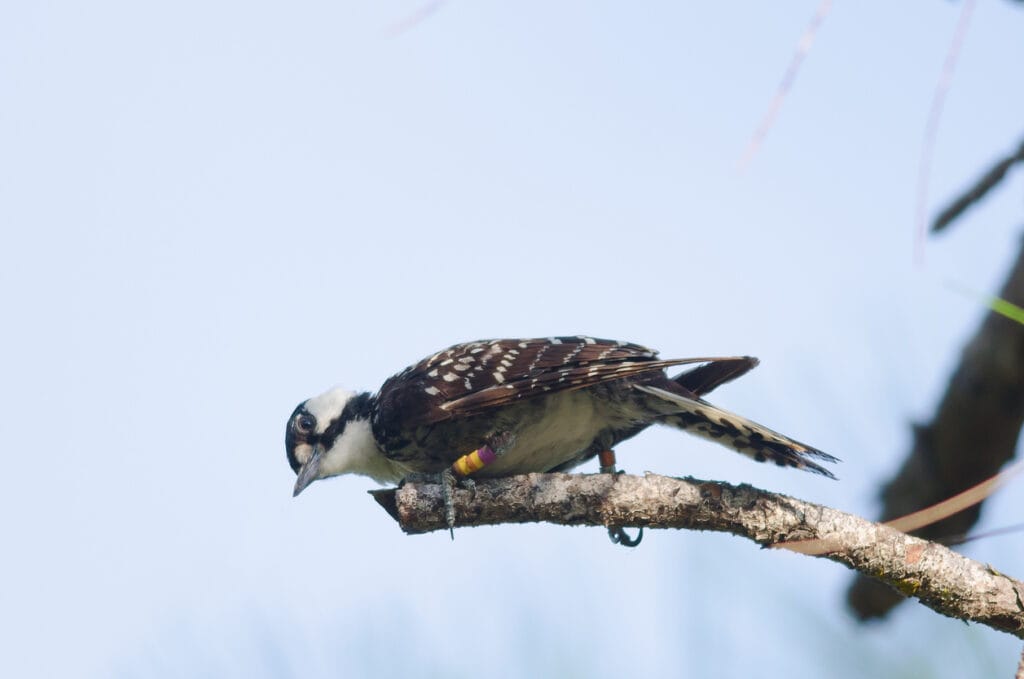
- Scientific name: Picoides borealis
- Length: 8-9 in
- Wingspan: 14-15 in
- Weight: 1.5-1.8 oz
The Red-Cockaded Woodpecker is also known as the Yankee Doodle Bird, which is a nod to the red badge-like spot on the male birds.
Meanwhile, the females are fully covered in back and white plumage, without the red marking. They only have the bright white cheek patch.
Sadly, its numbers are in decline.
Author Note: The once common southeastern bird is now a Federally threatened species across the United States. Yet, you could come across a patchy population in southeastern states like Florida, Alabama, Arkansas, Texas, Virginia, Louisiana, Oklahoma, and both Carolinas.
You have better odds of spotting the Red-Cocakded Woodpecker in open woodlands with old pine trees where they chisel out nests and drill for sap.
It’s not an easy job for this small bird, though. Excavating a home in a live pine tree is harder than it sounds, and it could take multiple years!
In conservation sites, the juveniles brought from Florida are settled in manmade cavities in pines. All to boost the Yankee Doodle Bird’s population.
7. Yellow-Shafted Northern Flicker
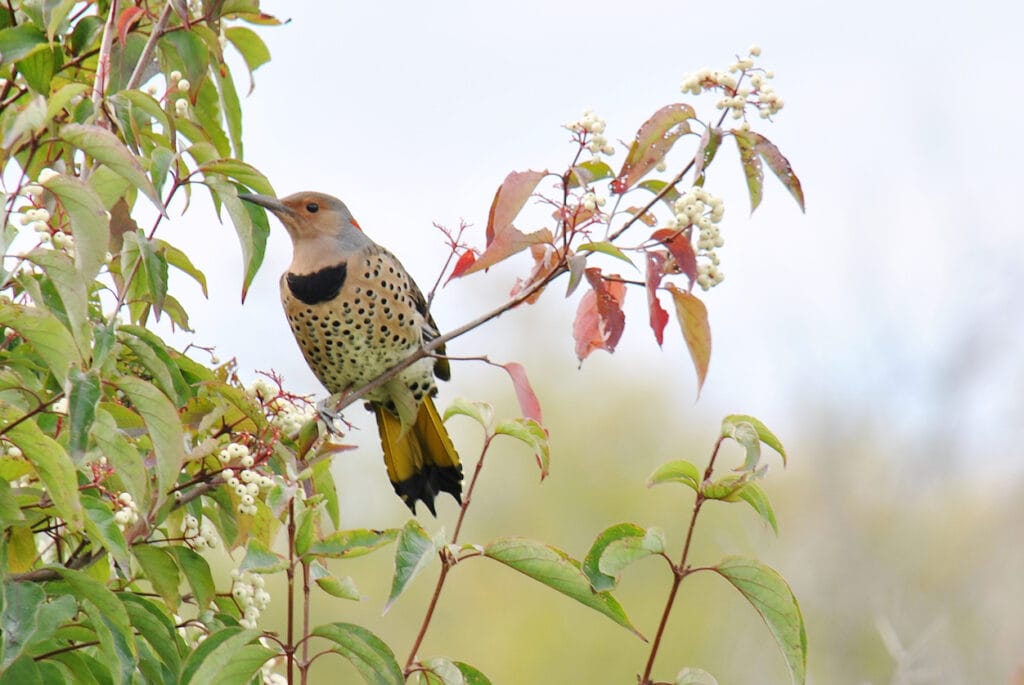
- Scientific name: Colaptes Auratus
- Length: 11-12.2 in
- Wingspan: 16.5-20.1 in
- Weight: 3.9-5.6 oz
The Yellow-Shafted Northern Flicker is one of the prettiest woodpeckers you can see. From the black collar-like spot to the spotted belly, a lot is going on visually.
If you manage to spot one of them in flight, you’ll understand where the name comes from.
Their wing undersides have a magnificent shade of yellow. Their tails are also adorned with yellow from below. All this gives the bird an unmistakable look once it spreads its wings!
Ironically enough, they’re one of few woodpecker species that actually like foraging on the ground instead of on trees.
Thankfully, this species of Northern Flickers live in almost every region of the United States all year round. This includes Florida’s coast and inland.
However, they’re not particularly fond of bird feeders. If your yard gets one of those curious visitors, you can tell the gender by looking for the black mustache that males sport with grace.
8. Pileated Woodpecker
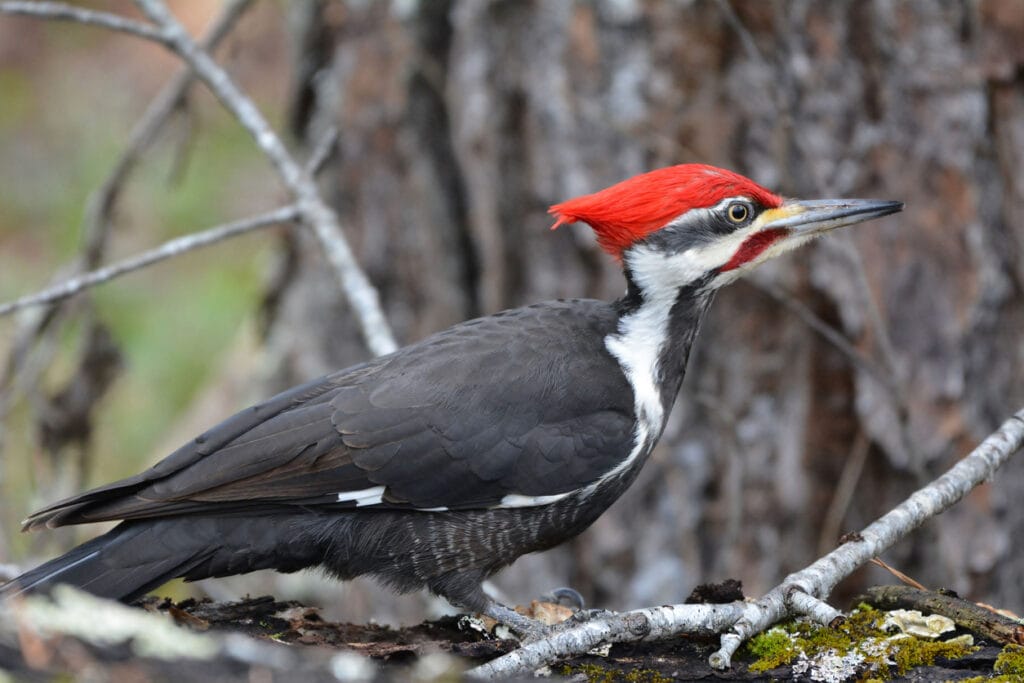
- Scientific name: Dryocopus pileatus
- Length: 16-19 in
- Wingspan: 20 in
- Weight: 7.9-14.1 oz
With a bright red tuft that looks like a mohawk, it’s hard to miss the Pileated Woodpecker. The males have a malar stripe to go with the hairdo. They’re quite the fashionable birds!
However, in-flight, they look more like crows than woodpeckers, but you can tell them apart with the alternating stripes under their wings that look like piano keys.
Since it has a strong peak to match its hefty body, it can leave significant damage on tree trunks. They’re more than willing to wreck the bark apart in the search for insects to eat.
So, if you’re wandering around in a deciduous or coniferous forest and see trees that look like something exploded its bark out, you’re probably close to a flock of those fierce drummers.
Sighting this bird is truly an unforgettable experience, especially since it’s easily one of the largest woodpeckers you’ll ever come across in North America!
9. Red-headed Woodpecker

- Scientific name: Melanerpes erythrocephalus
- Length: 9.25 in
- Wingspan: 16.7 in
- Weight: 2.7 oz
It’s hard for the Red-headed Woodpecker to hide from sight with dramatic colors, loud calls, and a friendly demeanor.
As the name implies, the Melanerpes erythrocephalus has a glossy red patch all over its head and neck. Plus, its wing is half black and half white, which is a top-identifying feature.
Top Tip: The transition between the plumage colors is sharp, and that often makes it look like a painted-on mask.
If you’re looking to see it yourself, the search shouldn’t be too hard. They’re widespread all over the eastern and central states of North America, including Florida. They prefer open country, groves, and orchards, but their population is often widely scattered.
Although they don’t look particularly strong, they can hammer acorns and nuts into small crevices to lodge them in place. This way, other wildlife won’t steal their food stock.
They’re not only pretty but also smart!
It’s probably the least looking like your typical woodpecker of all the birds on the list. Perhaps its vibrant color palette and bold behavior are why it was chosen as a Cherokee war symbol.
10. Ivory-Billed Woodpecker
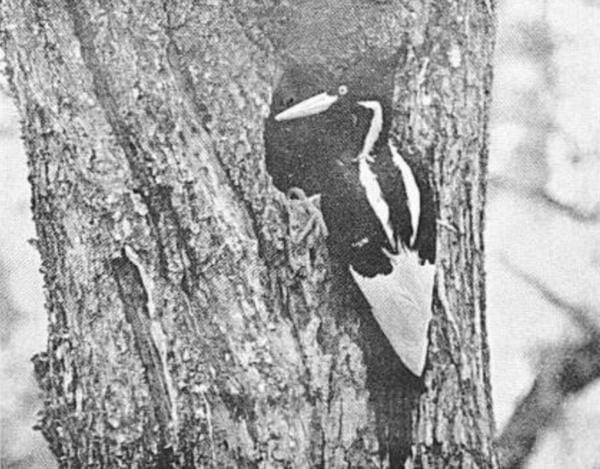
- Scientific name: Campephilus principalis
- Length: 18-20 in
- Wingspan: 30-31 in
- Weight: 16-20 oz
A hundred years or so ago, the Ivory-Billed Woodpecker was one of Florida’s common birds. Not anymore.
It was considered a critically endangered species by the U.S. Fish and Wildlife Service for a few years. Now, it’s so rare that some experts think it’s possibly extinct.
Don’t let this break your hope, though. Every now and then, one of those majestic creatures will pop for a surprisingly pleasant sighting. Who knows? You might be next!
Just keep in mind that your odds of seeing this rare bird are a little higher in Arkansas and Louisiana.
If you do spot the woodpecker, keep a respectful distance and try to confirm your identification before reporting it.
Top Tip: It has black and white plumage all over with a bright yellow eye. The males adorn a fabulous red nape and crest, too.
While their appearance makes for quite the view, you shouldn’t expect them to be the friendliest species.
They have much better eyesight than you do, and they’ve been hunted for ages. So, their fear/hatred for humans is not unreasonable.
It still would be a priced once-in-a-lifetime sighting for any birdwatcher!
Wrap Up
Spotting woodpeckers in Florida isn’t a challenging feat if you know what you’re looking for. With this guide, it should be easier for you to make a clear-cut identification.
If you’re making your way through the Sunshine State, keep your eye peeled out for those 10 species. You never know when your next sighting will be!
FAQ
The Red-bellied Woodpecker is arguably the most common woodpecker found in Florida.
Try these:
Corkscrew Swamp Sanctuary – Pileated Woodpecker
Disney Wilderness Preserve , St. Marks National Wildlife Refuge, Apalachicola National Forest – Red-cockaded & Red-headed Woodpecker
To find out where recent sightings of woodpecker have been, try eBird. You can search for the latest sightings or particular species or what has been seen in a certain area.




